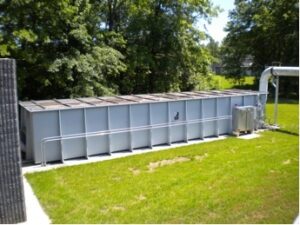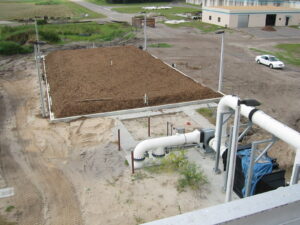How a Biofiltration System Works: A Practical Overview for Facility Managers
 Managing odor is an important part of running any industrial or municipal facility. Strong odors from wastewater, food processing, and waste management operations can affect nearby communities, create health concerns, and lead to regulatory problems. Many facilities are looking for odor control methods that are effective, reliable, and environmentally friendly.
Managing odor is an important part of running any industrial or municipal facility. Strong odors from wastewater, food processing, and waste management operations can affect nearby communities, create health concerns, and lead to regulatory problems. Many facilities are looking for odor control methods that are effective, reliable, and environmentally friendly.
One natural option that fits these needs is a biofiltration system. At Webster Environmental Associates (WEA), we help facilities plan, design, and operate biofiltration systems that solve real-world odor problems.
The Science Made Simple
A biofiltration system works by using microorganisms to break down odor-causing compounds in the air. As odorous air moves through a bed of specially selected media, bacteria and fungi living in the media absorb and digest the pollutants. Instead of releasing harmful gases, the system produces harmless byproducts like carbon dioxide, water, and simple salts.
The health of these microorganisms is key to good system performance. They need the right amount of moisture to stay active. They also need a stable pH range and steady airflow. If any of these conditions are off, the system may not work properly. That is why careful system design and regular monitoring are important.
Choosing the right media is another important part of making a biofiltration system work. Organic materials like wood chips, compost, or specially treated bark are common choices. Some facilities use synthetic media to get a longer lifespan and more consistent airflow. WEA matches the media type to the facility’s specific needs, based on odor strength, airflow rates, and maintenance goals.
Where Biofiltration Systems Work Best
Biofiltration systems are not a one-size-fits-all solution. They work best at facilities that produce steady, moderate-strength odors. Wastewater treatment plants use them at headworks, primary clarifiers, and sludge processing areas. Composting facilities use biofilters to treat air coming from curing piles and processing halls. Food processing plants use them for handling emissions from rendering and cooking operations.
One of the reasons biofiltration systems are so effective in these environments is because the types of odors — usually sulfur compounds or organic waste gases — break down well through biological action. Facilities that have consistent airflow and relatively stable temperatures tend to get the best results with biofilters.
In some cases, biofiltration can also be used alongside other systems. For example, a facility may use a chemical scrubber for high-peak odor events and a biofilter for day-to-day emissions. WEA helps clients decide if a single system or a combination approach is the better fit.
Key Components of a Biofiltration System
 A basic biofiltration system has a few key parts. The most important is the media bed. This is where the microorganisms live and where the real odor treatment happens. The media must be selected for durability, drainage, and microbial support.
A basic biofiltration system has a few key parts. The most important is the media bed. This is where the microorganisms live and where the real odor treatment happens. The media must be selected for durability, drainage, and microbial support.
Airflow systems are another critical part. Fans or blowers move contaminated air through the biofilter at the right speed. Too fast, and the odors won’t be treated. Too slow, and the system may clog or create other problems.
Irrigation systems keep the media moist. In many facilities, the biofilter is watered using simple spray headers or drip systems. Automated controls often adjust moisture based on weather conditions or air temperature.
Monitoring tools help operators track airflow, pressure drops, temperature, and moisture levels. Regular checks allow small problems to be fixed before they become major issues. WEA helps facilities set up practical, easy-to-follow monitoring programs so biofilters stay reliable.
How WEA Designs Smarter Biofiltration Systems
At Webster Environmental Associates, we take a careful, data-driven approach to biofiltration design. We always start with a thorough site evaluation. We sample and test air from different parts of the facility to understand what types of odors are present and at what levels.
From there, we size the biofilter properly based on real airflow rates and odor concentrations. We select the right type of media based on performance goals and budget. We also design the airflow, irrigation, and monitoring systems so that everything works together smoothly.
We do not take shortcuts or rely on generic designs. Every facility is different, and biofilters must be customized to match each site’s specific needs. Our goal is to build systems that not only meet regulatory standards but also work reliably year after year.
WEA also provides support after installation. We offer maintenance plans, training for operators, and regular system checkups. Our team is available to troubleshoot issues, recommend improvements, and help clients keep their systems performing at a high level.
Ready to Explore Biofiltration? Let’s Talk
Biofiltration systems are a smart, natural choice for many facilities looking to improve their odor control. When designed and managed correctly, they offer strong performance with low environmental impact and manageable operating costs.
At WEA, we specialize in helping clients build biofiltration systems that work. Whether you are upgrading an existing system or starting from scratch, our team can guide you every step of the way. Contact us today to schedule an odor evaluation or discuss your project needs.
